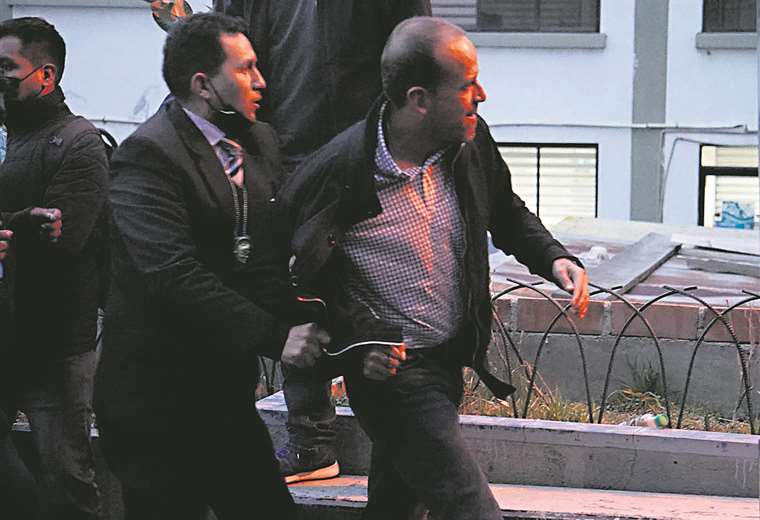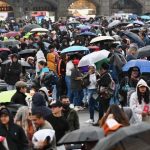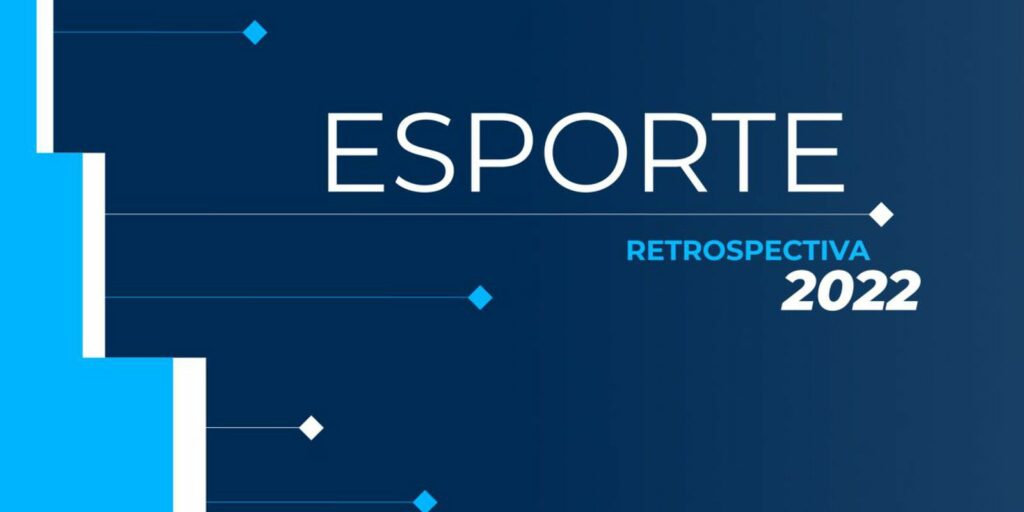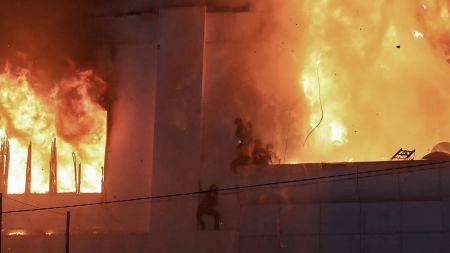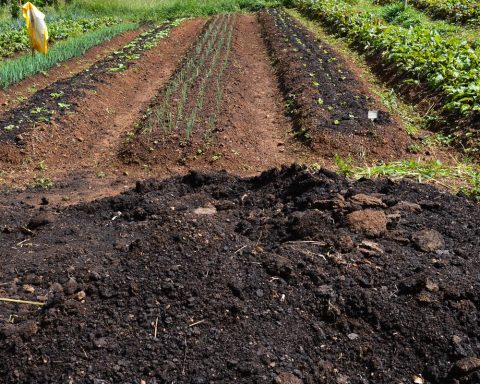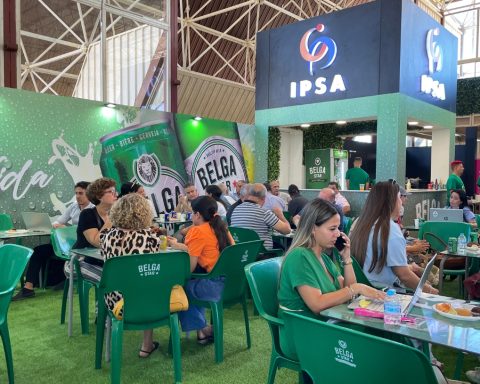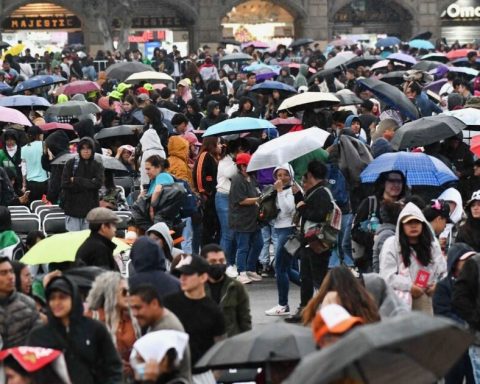December 29, 2022, 4:00 AM
December 29, 2022, 4:00 AM
The arrest warrant was issued two months ago in La Paz, but the operation was carried out yesterday, three days after the New Year. A special group of the Police, which acted with hooded personnel, intercepted the governor of Santa Cruz, Luis Fernando Camacho, when he arrived at his home. It happened after noon and, according to witnesses, the operation was violent.
Late in the afternoon, dressed in a dark jacket and checked shirt, Camacho arrived in La Paz, heavily guarded by uniformed and plainclothes agents. By that time, in Santa Cruz, blockades had already been installed on several avenues and the headquarters of the Santa Cruz Prosecutor’s Office was set on fire. In addition, there was a protest on the Viru Viru platform that blocked all flights.
The president of the Committee for Santa Cruz, Rómulo Calvo, affirmed that “paid groups had caused vandalism.” The vice president of the institution, Fernando Larach, indicated that they had “infiltrated” and protested the lack of protection from the Police. “It is very strange that there are no uniformed officers in the Prosecutor’s Office,” he said, acknowledging that, in other sectors, there was a legitimate protest against the apprehension of the authorities. The tension took over the night and the streets of the city emptied.
Martín Camacho, lawyer for the Santa Cruz leader, was the first to react. At about 2:15 p.m. he reported a “irregular intervention by the Police” and accused her of perpetrating “a kidnapping” against the authority, because there was no prior summons. He affirmed that he was transferred to Viru Viru because that was what the people who were with the governor at the time of his violent capture, right in front of his home, informed him.
But, the police operation, baptized as “Special Wolf”, mobilized, precisely, agents of the group “Los Lobos” who are part of the Intelligence Directorate of the Special Force to Fight Drug Trafficking (Felcn). According to police sources, several “decoys” were activated. One of them arrived at the Viru Viru airport and was followed by people close to Camacho, including his lawyer and several of his assembly members, including Zvonko Matkovic, president of the Santa Cruz deliberative body.
Once there, the officers reduced the governor’s driver who was in the group. They activated their regulation weapons against one of the motorized windows. Meanwhile, another group of uniformed Camacho was discreetly transferred to the Viru Viru airport, where he was boarded in a SuperPuma helicopter, operated by the Red Devils Task Force, an anti-drug unit that coordinates with the Bolivian Police. This is how they took him to Chimoré, in the heart of the Cochabamba tropics, the area of the country that is known as a MAS stronghold.
In the middle of the confusion and before 17:00, Dozens of people broke into the platform of the Viru Viru Airport before the weak presence of conscripts who were overwhelmed by the protest. The people wanted to prevent Camacho from being transferred to La Paz, from where the prosecutor Omar Mejillones issued the arrest warrant against Camacho on October 31.
According to that requirement, Camacho is under investigation for “terrorism”, a crime that he could have committed in the context of the 2019 political crisis, which broke out after the resignation of Evo Morales from the Presidency and the annulment of the elections. The order stresses the prerogative of the Public Ministry of request the necessary police assistance, but within a period of 48 hours, which has already expired.
The defense attorney for the departmental authority affirmed that this determination was not known in October and recalled that Mejillones was in Santa Cruz, in mid-July, to take his client’s statement “and in compliance with an appeal that was accepted.”
But, that proceeding was suspended after reports of “alleged threats that the Prosecutor’s Office failed to explain,” said Martín Camacho. In La Paz, former deputy Lidia Patty (MAS), who filed the complaint against the Governor of Santa Cruz, highlighted the operation and asked “that he be sentenced to 30 years in prison”, the maximum penalty in Bolivia, for those killed in the Sacaba and Senkata massacres that occurred in November 2019.
This political crisis occurred after the resignation of Evo and the installation of the transitional government of Jeanine Áñez. The former president was already sentenced to 10 years in prison for decisions contrary to the law that she committed when she took office, but the government of Luis Arce has now asked to try her for “genocide” before an ordinary court.
In a brief message sent from his accounts on social networks, the Minister of Government, Eduardo del Castillo, confirmed at 2:45 p.m. the “apprehension” of the regional authority. Then, and after two hours, he explained: “We have instructed that the corresponding medical evaluation be carried out, respecting constitutional rights and human rights as we do with any person deprived of liberty.” This criterion was issued before Camacho saw a judge.
Around 6:00 p.m., the State Attorney General’s Office, also in a statement, confirmed its participation in the operation. “It is not about a kidnapping or political persecutionOn the contrary, it was issued in the month of October of this administration and has jurisdictional control by the Tenth Criminal Investigation Judge of the Departmental Court of Justice of La Paz.
Likewise, the citizen Luis Fernando Camacho has full knowledge of said process, since its beginning on November 28, 2020, as provided by the Bolivian legal system, ”says the document. In Holy Cross, His lawyers denied that Camacho was aware of the process.
“We do not know in which of the many processes that have been opened to the governor this resolution has been issued (of apprehension), which is Minister Del Castillo, who has said through Twitter —look at the informality of the population— to give a report on such a vandal act through Twitter,” said Martín Camacho, the governor’s lawyer, who announced actions in favor of the departmental authority that is already in La Paz.
The “Special Wolf” operation was also carried out in La Paz with various lures. At the end of the afternoon, the apprehended governor arrived at the El Alto Air Base and from there dozens of troops in trucks, jeeps and motorcycles mobilized to the offices of the El Alto Special Force to Fight Crime (Felcc). But it was another group that took Camacho to the Felcc de La Paz.
The offices of this police unit are just three blocks from Plaza Murillowhere the Casa Grande del Pueblo is located and where Arce held his last cabinet meeting of this year in the morning.
“We will not go back an inch on our progress”, wrote Arce after the meeting with his ministers and in the afternoon, during the congress of the Federation of Peasants of Oruro. There he spoke “of remembering the conditions” that allowed the MAS to return to power after the 2020 elections, “as a political instrument, as an organized people.” Thus, he called for the “unity” of the organizations, just at a time marked by the internal crisis in the MAS.
“This is a response from the Government; not against Camacho, but against an entire region that it has democratically questioned all the policies of the central government; It is a violent response against the people of Santa Cruz who have elected an authority and who have had the audacity to demand freedom. There has not been an apprehension; It was a kidnapping because a prior summons was not issued,” said the advisory secretary of the Santa Cruz Governorate, Efraín Suárez, last night.
Camacho was one of the key protagonists in the mobilizations for a census “timely and transparent” and the indefinite strike that lasted for 36 days, between October and November.
“It is truly unfortunate to see our city in convulsion. We repudiate the violent and arbitrary way in which Governor Luis Fernando Camacho was apprehended, trampling his rights and attacking democracy. My solidarity with him and his family, ”said Vicente Cuéllar, rector of the Gabriel René Moreno Autonomous University (Uagrm), who was also part of the Inter-institutional Committee that promotes the next census.
At night, the city weather turned sharply. Dozens of vehicles rushed to the pumps and emblematic roundabouts such as those of Madre India and Virgen de Cotoca were blocked. The memory of the 36-day strike returned to the city.
The Cruceñidad Assembly will take action this Thursday and it is expected that, in La Paz, a judge will determine the fate of Camacho.
